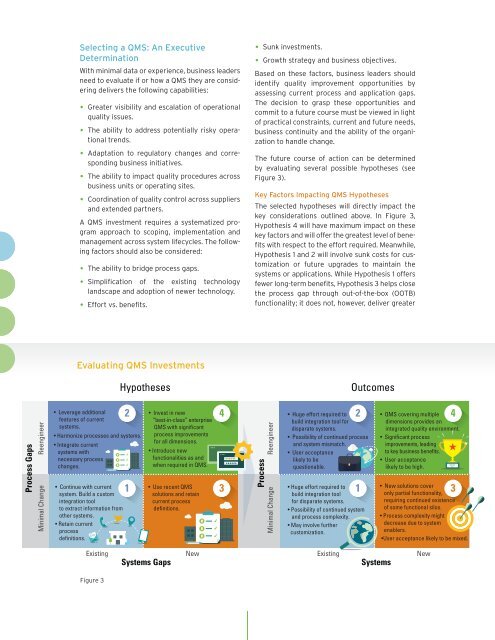• Decoding Quality Management Systems
1RF8NS1
1RF8NS1
Create successful ePaper yourself
Turn your PDF publications into a flip-book with our unique Google optimized e-Paper software.
Selecting a QMS: An Executive<br />
Determination<br />
With minimal data or experience, business leaders<br />
need to evaluate if or how a QMS they are considering<br />
delivers the following capabilities:<br />
<strong>•</strong> Greater visibility and escalation of operational<br />
quality issues.<br />
<strong>•</strong> The ability to address potentially risky operational<br />
trends.<br />
<strong>•</strong> Adaptation to regulatory changes and corresponding<br />
business initiatives.<br />
<strong>•</strong> The ability to impact quality procedures across<br />
business units or operating sites.<br />
<strong>•</strong> Coordination of quality control across suppliers<br />
and extended partners.<br />
A QMS investment requires a systematized program<br />
approach to scoping, implementation and<br />
management across system lifecycles. The following<br />
factors should also be considered:<br />
<strong>•</strong> The ability to bridge process gaps.<br />
<strong>•</strong> Simplification of the existing technology<br />
landscape and adoption of newer technology.<br />
<strong>•</strong> Effort vs. benefits.<br />
<strong>•</strong> Sunk investments.<br />
<strong>•</strong> Growth strategy and business objectives.<br />
Based on these factors, business leaders should<br />
identify quality improvement opportunities by<br />
assessing current process and application gaps.<br />
The decision to grasp these opportunities and<br />
commit to a future course must be viewed in light<br />
of practical constraints, current and future needs,<br />
business continuity and the ability of the organization<br />
to handle change.<br />
The future course of action can be determined<br />
by evaluating several possible hypotheses (see<br />
Figure 3).<br />
Key Factors Impacting QMS Hypotheses<br />
The selected hypotheses will directly impact the<br />
key considerations outlined above. In Figure 3,<br />
Hypothesis 4 will have maximum impact on these<br />
key factors and will offer the greatest level of benefits<br />
with respect to the effort required. Meanwhile,<br />
Hypothesis 1 and 2 will involve sunk costs for customization<br />
or future upgrades to maintain the<br />
systems or applications. While Hypothesis 1 offers<br />
fewer long-term benefits, Hypothesis 3 helps close<br />
the process gap through out-of-the-box (OOTB)<br />
functionality; it does not, however, deliver greater<br />
Evaluating QMS Investments<br />
Hypotheses<br />
Outcomes<br />
Process Gaps<br />
Minimal Change Reengineer<br />
<strong>•</strong> Leverage additional<br />
features of current<br />
systems.<br />
<strong>•</strong> Harmonize processes and systems.<br />
<strong>•</strong> Integrate current<br />
systems with<br />
necessary process<br />
changes.<br />
<strong>•</strong> Continue with current<br />
system. Build a custom<br />
integration tool<br />
to extract information from<br />
other systems.<br />
<strong>•</strong> Retain current<br />
process<br />
definitions.<br />
2 4<br />
<strong>•</strong> Invest in new<br />
“best-in-class” enterprise<br />
QMS with significant<br />
process improvements<br />
for all dimensions.<br />
<strong>•</strong> Introduce new<br />
functionalities as and<br />
when required in QMS.<br />
1 3<br />
<strong>•</strong> Use recent QMS<br />
solutions and retain<br />
current process<br />
definitions.<br />
Process<br />
Minimal Change Reengineer<br />
2<br />
<strong>•</strong> Huge effort required to<br />
build integration tool for<br />
disparate systems.<br />
<strong>•</strong> Possibility of continued process<br />
and system mismatch.<br />
<strong>•</strong> User acceptance<br />
likely to be<br />
questionable.<br />
1<br />
<strong>•</strong> Huge effort required to<br />
build integration tool<br />
for disparate systems.<br />
<strong>•</strong> Possibility of continued system<br />
and process complexity.<br />
<strong>•</strong> May involve further<br />
customization.<br />
4<br />
4<br />
<strong>•</strong> QMS covering multiple<br />
dimensions provides an<br />
integrated quality environment.<br />
<strong>•</strong> Significant process<br />
improvements, leading<br />
to key business benefits.<br />
<strong>•</strong> User acceptance<br />
likely to be high.<br />
3<br />
<strong>•</strong> New solutions cover<br />
only partial functionality,<br />
requiring continued existence e<br />
of some functional silos.<br />
<strong>•</strong> Process complexity might<br />
decrease due to system<br />
enablers.<br />
<strong>•</strong>User acceptance likely to be mixed.<br />
Existing<br />
<strong>Systems</strong> Gaps<br />
New<br />
Existing<br />
<strong>Systems</strong><br />
New<br />
Figure 3<br />
cognizant 20-20 insights 4



